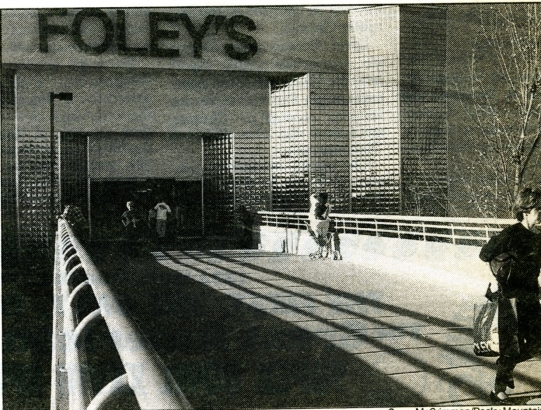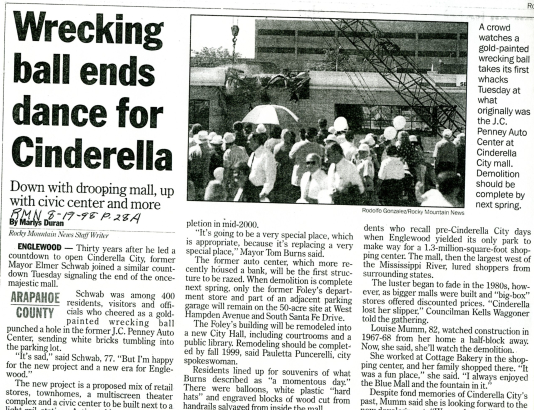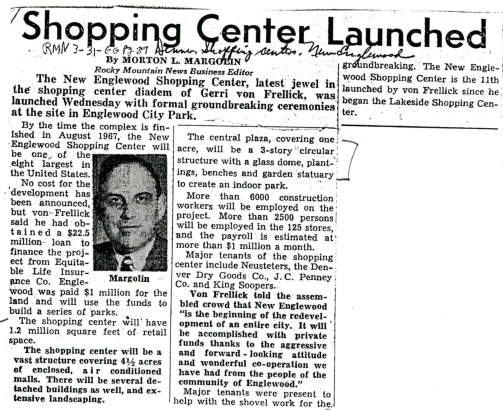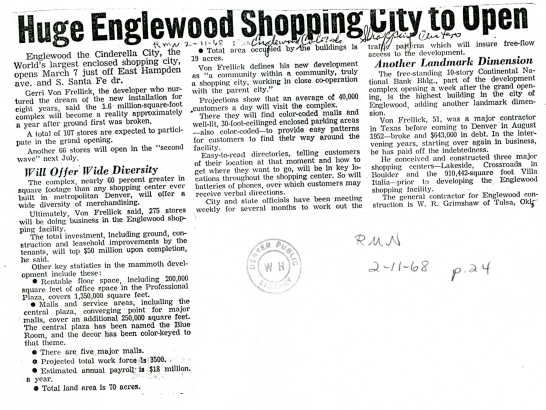On March 7, 1968, after nearly a decade of planning, Cinderella City opened its doors. To learn more about how the mall came to life, check out Cinderella City: The Rise and Fall a Memorable Mall (Part 1)
Cinderella Arrives at the Ball
Cinderella City's opening weekend, and subsequent couple of decades, were hugely successful. The excitement of opening day was enhanced by huge special sections in both Denver daily newspapers.
Oddly enough, the mall wasn't really complete when it opened its doors that day. Only 100 stores were open, but Von Frellick was insistent that his mall open on time. The fact that he would lose around $400,000 a month in rent (about $2.8 million in 2017 dollars) certainly factored into his decision to launch in March. Plans were made for a full grand opening, with all 250 stores, in June.
To help deal with expected onslaught, the Englewood Police Department brought in 30 off-duty Denver Police officers as reinforcements. Englewood Police Chief Jack Clasby described the opening as, "the largest commitment of law enforcement officers in the history of Englewood."
Chief Clasby was hardly the only one to embrace superlatives in regard to Cinderella City. The Rocky Mountain News' special section is bursting with facts exclaiming the new mall's many wonders. These ranged from the 14,000 parking spaces to the three-deck refrigerated cases at the Cinderella City King Soopers, to the four massive air conditioning units that kept the dream from overheating.
Englewood Mayor Elmer Schwab was able to contain himself enough to speak these measured words regarding his city’s new crown jewel, saying the event was, “...the greatest moment ever in Englewood's history - an Alice in Wonderland come true."
Though opening day at Cinderella City didn’t draw a million shoppers, it definitely drew thousands. Von Frellick himself presided over the opening ceremonies which included the ceremonial launch of the mall's signature water fountains. These sorts of fountains were a mainstay in malls across the country and, it's fair to say, that subsequent mall fountains were definitely inspired by the Blue Mall's massive water works.
The Golden Years
Cinderella City’s unique design, featuring six distinct shopping areas – the Blue Mall, the Rose Mall, the Sunflower Mall, the Gold Mall, the Shamrock Mall, and Cinder Alley – was a huge hit with shoppers from across the Rocky Mountain West.
That success filled the City of Englewood's coffers with a torrent of tax revenue. According to a Denver Post report from May 20, 1970, Cinderella City's impact on Englewood was nothing short of incredible. Among other things, all the fairy tale money allowed Englewood to increase its student spending from $670 per pupil to $824.87.
Cinderella City was also a boon for the man who dreamed it up. In 1978, Von Frellick sold his share in the mall to a group of New York investors for $35 million (about $130 million in 2017 dollars). By that point, Cinderella City's 235 merchants had generated more than $45 million in sales taxes for the City of Englewood.
The good times, however, were not to last. Just as in the fairy tale of the same name, Cinderella City had an appointment with the midnight hour.
The Clock Strikes Midnight
Retail shopping habits are a notoriously fickle beast. By the time the 1990s arrived, consumers weren't quite as impressed by fountains and chandeliers as they'd once been.
In Cinderella City's case, a group of new malls, including Southwest Plaza and Westminster Mall, had poached many of its customers who'd once been willing to drive great distances for the chance to shop at the West's largest shopping center. Slowly but surely, these competitors choked the life out Englewood's crown jewel.
As early as 1991, local retail analysts had written off the mall entirely. In an interview with the Denver Post date December 6, 1991, an unnamed retail expert said, "When it was built, it was the hottest thing in town -- it was one of the biggest malls in the country and, in our little cow town, was a unique attraction. But as suburban malls proliferated, it was squeezed from all sides and its immediate area isn't that affluent."
In 1992, the mall only generated $1.85 million in tax revenues and that was down from $3 million in 1981.
Besides changing consumer habits, Cinderella City was also dealing with a ghost from its pre-mall, pre-Englewood City Hall, days. Cinderella City, it turns out, was built on what had once been the Englewood town dump.
After a few decades of supporting the weight of one of the world's biggest shopping malls, the ground where the dump had been was shifting, creating serious structural problems for the mall. Towards the very end of Cinderella City's run, Cinder Alley was deemed too unsafe to host shoppers and was shuttered entirely.
As the 1990s drew to a close, Cinderella City was in dire shape. Most of its retail tenants had long since fled. The few that remained, around three when they finally shut down for good, were in desperate need of paying customers.
Not only were there not many places to actually shop, but by the late 1990s, Cinderella City was a pretty spooky place to visit. All that empty space was hardly the stuff of a pleasant afternoon of shopping. Mall security guards complained that gang members used the dead space to commit, "felonious acts."
After a few futile attempts at reviving Cinderella City, the mall's owners and the City of Englewood threw in the towel. On August 18, 1998, the process of demolition began and Cinderella City's night at the ball, all thirty years of it, was done. Once again, Elmer Schwab oversaw the proceedings.
By the end of the year, demolition crews were hard at work leveling the once-glamorous complex.
Aftermath
Despite Cinderella City's shabby end, the property on which it stood remained quite valuable. In 2000, the space was re-developed to hold the new Englewood City Hall, a Wal-Mart and other, more modern, retail options.
Will these facilities meet the same fate as Cinderella City? If history is any guide, a new set of stores will be standing on that same plot in just a few decades.
If you enjoy Denver history, see more articles like this on our Facebook page!


![A long hallway with a sign reading "Blue Mall" at Cinderella City shopping center in Englewood, Colorado, has small stores on either side. "Harry's Hutel [sic]" has a poster of W. C. Fields, balloons, and other merchandise on display; "Musicland" has scaffolding in front, and another shops has a canopy. "Pier 1 Imports" is at the end of the mall. A dropped ceiling with flourescent lighting in overhead.](/sites/history/files/styles/blog_image/public/cdm_9289_0.jpg?itok=aANnFqsY)




Comments
HI Linda - Glad you enjoyed
HI Linda - Glad you enjoyed the blog and the trip down memory lane! Sorry to say we didn't run across the whereabouts of the double-decker carousel. Maybe it's sitting in a barn somewhere!
I don't think very many
I don't think very many people understand the economic impact CC had to the area and especially the city of Englewood. As stated in your article, just the contribution per student was huge. Amazing number of dollars flowed through the city coffers during those times.
Hi Larry - Thanks for reading
Hi Larry - Thanks for reading and commenting. Those revenue numbers really blew me away. That was quite the cash cow for a very long time.
I have many great memories of
I have many great memories of C City, as we called it; however, what escapes my memory is the name of the head shop in Cinder Alley. By chance do any readers remember?
I think it was Big Value
I think it was Big Value Records & Tapes.
Where are the photos of the
Where are the photos of the highest grossing Disney theater in the country General Cinema Corp. of Boston, this theater seated over 1200 it stood high and pride play every DISNEY film that was released during the period
We called it Cin City!
We called it Cin City! Parents would let their toddlers play in the fountains, which gave security officers something to do. KGMC had a fishbowl studio there and it was fun to watch them do their "Dial A Score" feature on the weekends. The announcer would read scores off giant chalkboards in the studio. Parking was atrocious, and oftentimes the upper decks would shake while you were walking in or out of the mall. If you couldn't find what you were looking for at Cin City...it probably didn't exist!
About the carousel...There is
About the carousel...There is one at the Oak Park Mall in Overland Park, Kansas. The first time I saw it I think I yelled out that I knew that carousel- people looked at me rather oddly anyway. It is identical to the one at Cinderella City. I had to ride it several times and sit in the very same places I sat at the one in Cinderella City. I made several attempts at finding information and finally someone called me back. The person who contacted me told me he knew the scenery plates had been re-done to represent popular sites and places in this area and that it had been purchased from a mall that had been closed. It could just be hope...
I was born in South Denver in
I was born in South Denver in 1960. Growing up I this era, and in this part of Denver, Cinderella City was a pivotal hangout my teenage years. I also had my 1st retail job at the New Englewood Pet Store.
You could get there on on #12 & #0 buss lines. Being able to do to do your “one stop” Christmas & Birthday shopping was also very cool.
Before Southglenn opened, all
Before Southglenn opened, all of the south suburbs shopped at Cinderella City. I saw Santa in his Cinderella carriage more than once. I have very fond memories of the deli on the main floor, near the central fountain, Farrell's, where we celebrated birthdays, a couple of great candy stores -- it goes on and on. My best friend and I scared our mothers half to death by missing our meet-up time during one memorable shopping trip. Cinderella City was always an adventure.
Add new comment